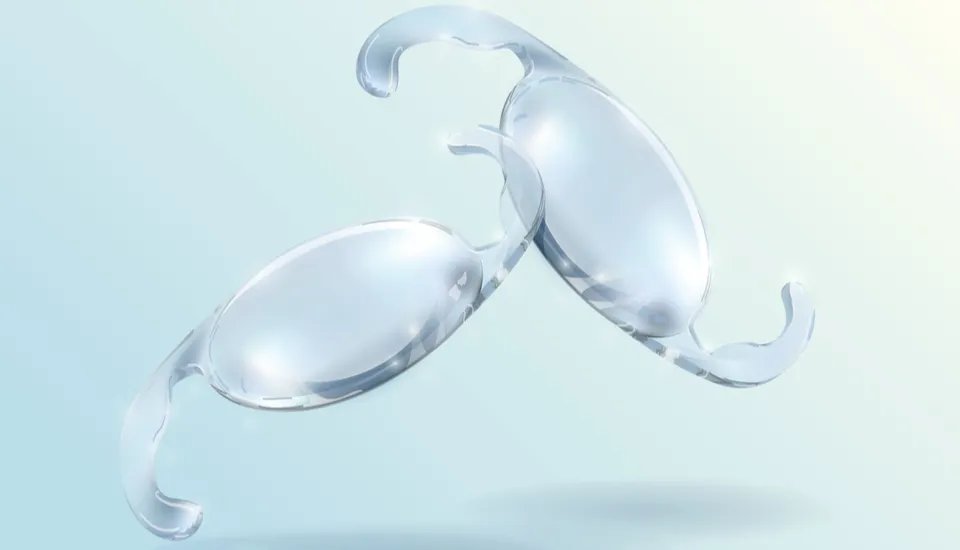Smart Lens
Smart Lens

The Smart Lens or Intraocular Lens is an implant (artificial lens) made of a biocompatible material that replaces the natural lens when it loses its function.
The artificial lens consists of two elements: optical and supportive. The optical part is a transparent lens that ensures the correct focusing of light rays and provides good vision, and the supporting (haptic) part consists of two clamps and allows you to fix the Intraocular Lens (IOL) to the natural lens capsule.


Intraocular Lenses are used for
- Treatment of cataracts of any severity (even in combination with other pathologies);
- Refractive errors due to severe myopia, farsightedness or astigmatism.
Characteristics of modern intraocular lenses:
The first IOLs were rigid implants that had to be cut to the length of the lens, making the operation a traumatic intervention with a long recovery period. What are the characteristics of modern artificial lenses used in ophthalmology?

- Optical parameters. Each IOL has its own characteristics designed to maximize visual function. Optical power indicators are calculated during the examination based on the individual needs of the patient and the characteristics of the intervention.
- Excellent biocompatibility. Modern materials of artificial lenses do not cause allergies, except for possible rejection of the lens.
- Flexibility and elasticity. IOLs are so flexible that when folded through micro-access they can be placed inside the eye, flattening in the capsular bag.
- UV filter. The artificial lens is able to protect the retina from ultraviolet radiation thanks to a color filter for a specific spectrum of light radiation. Color reproduction is not affected.
- Correction of spherical distortions. Aspheric lenses with complex surface geometry improve the quality of vision at twilight and prevent glare.
- Astigmatism correction. In some combined pathologies (e.g. cataract + astigmatism), it is preferable to fit toric lens models that solve both problems simultaneously.
- Elimination of age-related farsightedness. After 40-45 years, the lens gradually loses its ability to quickly refocus near/far due to reduced flexibility. The accommodation process is impaired, requiring correction with glasses for clear vision of nearby objects. Special multifocal new generation IOLs compensate for the lost accommodative abilities, providing excellent vision at near, far and intermediate distances.

Implantation methods of intraocular lenses:
An intraocular lens (IOL) can be placed in the anterior or posterior chamber of the eye. Lens models differ in size, shape of the support connections and material. The main task is to fix the lens in such a way that it does not touch the lens and does not affect the natural circulation of fluid inside the eye.
Characteristics of anterior chamber implantation:
- In this part of the eye there is enough free space for a stable fixation of the lens, so this procedure belongs to operations of medium complexity.
- Optical calculations and measurements are relatively simple.
- The implant material can be rigid or flexible, elastic.
- The lens can be placed in the corner of the camera or on the iris.
- Possible complications: risk of damage to the iris or lens, reduction in the number of endothelial cells, changes in the shape of the pupil, chronic inflammation.
- Another feature of anterior chamber lenses is that they can be seen by others due to glare.
Characteristics of posterior chamber implantation:
- This implantation method is technically more difficult because there is much less free space in the posterior chamber of the eye.
- The optical calculation is complex and requires very precise special measurements.
- The lens material must be elastic and repeat the shape of the lens.
- Possible complications: violation of the free circulation of intraocular fluid and the risk of developing cataracts.
- Posterior chamber lenses cannot be seen from the side, they can only be seen with a special examination.
- As you can see, both methods have their advantages and disadvantages. Modern clinics usually implant posterior chamber lenses if the patient’s vision is up to -14 diopters. But the final choice can only be made by a qualified doctor after a thorough examination of all the features of the patient’s visual system.

- Monofocal lenses cannot change the curvature by adapting to different distances as with a natural lens. Vision will be corrected for distance and glasses will be needed for near work.
- Multifocal. The optical properties of the lenses are similar to those of a natural lens. The complex design of the optics allows the patient to see equally well both far and near after wearing such a lens.
- Toric lenses provide vision correction against astigmatism thanks to special optics with an internal cylinder.
- Multifocal toric. They have a combined effect – while correcting astigmatism, the patient receives almost 100% vision, which he did not have before surgery.
- Lenses with additional protective functions – color filters. Such models are equipped with yellow pigments that do not allow blue rays from the invisible part of the light spectrum to pass to the retina.

Intraocular Lenses
For:
- People with myopia.
- People with hyperopia.
- Individuals with astigmatism.
- People with cataracts.
Not for:
- Those with optic nerve atrophy, retinal dystrophy, or any inflammatory process in the fundus.
- Individuals with chronic inflammation in the choroid (uveitis).
- Those with lens subluxation.
- Individuals who have undergone previous eye surgery (on the retina and vitreous).
- Pregnant and breastfeeding women.
Duration of Intraocular Lens Procedure:
- Total of 50-60 minutes.
Recovery Timeline for Intraocular Lenses:
- Full vision is regained the day after surgery.
- The patient can return to work after 10 days.
Possible Risks with Intraocular Lenses:
- There is a risk of developing a small cataract as a result of lens implantation.
- Blurred vision, double vision, halos, and corneal clouding due to endothelial cell loss.
- In extreme cases, though very rare, there may be a risk of complete vision loss.
